Welcome, fellow go-kart enthusiasts! If you share our passion for go-kart racing, you understand that choosing the perfect tires can significantly impact your performance on the track. This comprehensive guide will delve into everything you need to know about go-kart tires.
We will discuss the various types of tires, their unique characteristics, and how to select the best ones for your racing experience.
Furthermore, we’ll cover essential maintenance tips to keep your tires in optimal condition, ensuring you confidently hit the track and achieve your best lap times. So, join us on this exciting journey through the world of go-kart tires!
Related Article: Ultimate Guide to Go-Kart Tire Pressure & Performance
Types of Go-Kart Tires
Understanding the different types of go-kart tires is crucial for selecting the right set for your needs. Each tire type has unique features designed to perform optimally under certain conditions. Let’s explore the various go-kart tire types and their benefits:
Oval Tires
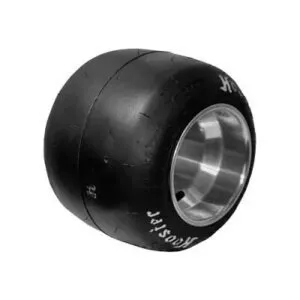
Oval tires are specifically designed for oval racing, where tracks consist of two long straights connected by two tight turns. These tires have a distinct tread pattern and sidewall construction to handle the unique demands of oval tracks, such as the continuous lateral forces experienced during cornering. Oval tires are known for their consistent grip, predictable handling, and excellent durability, making them the ideal choice for racers who frequent oval tracks.
Slick Tires
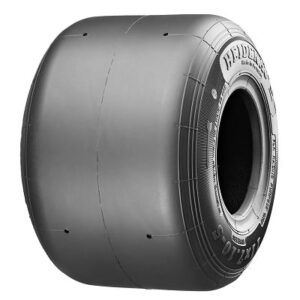
For those racing on smooth, paved surfaces in dry weather conditions, slick tires are the go-to option. These tires have no tread pattern, which maximizes the contact area with the track. This increased contact area results in improved traction, better handling, and faster lap times. Slick tires are widely popular in go-kart racing, offering maximum grip on dry tracks and allowing racers to push their karts to the limit.
Wet Tires
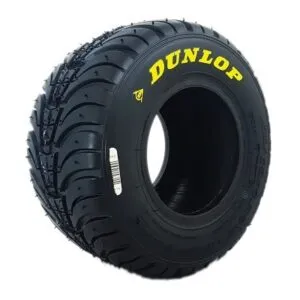
When the rain starts to fall and the track becomes slippery, wet tires, also known as rain tires, come to the rescue. Wet tires have a specialized tread pattern designed to channel water away from the contact patch, reducing the risk of hydroplaning and providing a better grip on wet surfaces. The grooves in the tread pattern disperse water efficiently, ensuring that the tire maintains contact with the track even in heavy rain. Wet tires are essential for racers who want to maintain control and speed in wet conditions.
Dirt Tires
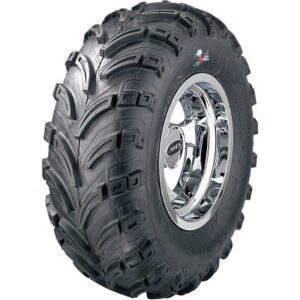
Off-road and dirt racing enthusiasts require a tire that can handle rough terrain challenges. Dirt tires feature an aggressive tread pattern and a more robust construction to tackle uneven surfaces and provide the necessary grip for optimal performance. These tires are designed to bite into loose dirt, gravel, or sand, ensuring that racers can maintain control and speed in off-road conditions. If you’re planning to race on dirt tracks, investing in a quality set of dirt tires is necessary.
Concession Tires
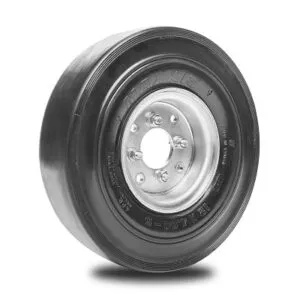
Rental go-kart operators need tires that can withstand the demands of constant use while balancing grip, durability, and cost. Concession tires are engineered to meet these requirements, offering a versatile solution for rental kart applications. These tires are built with a more durable compound and a tread pattern that provides consistent performance across various track surfaces and conditions. While concession tires may not offer the same level of grip as specialized racing tires, they provide a safe and cost-effective option for rental kart operators.
Now that we have covered the different types of go-kart tires, it’s essential to understand how to choose the right set for your needs. In the following sections, we will discuss factors to consider when selecting go-kart tires and how to choose the right tire compound to achieve the perfect balance between grip and durability. We will also offer tips on tire maintenance to ensure you get the most out of your investment and achieve the best possible performance on the track.
Choosing the Right Tire Compound
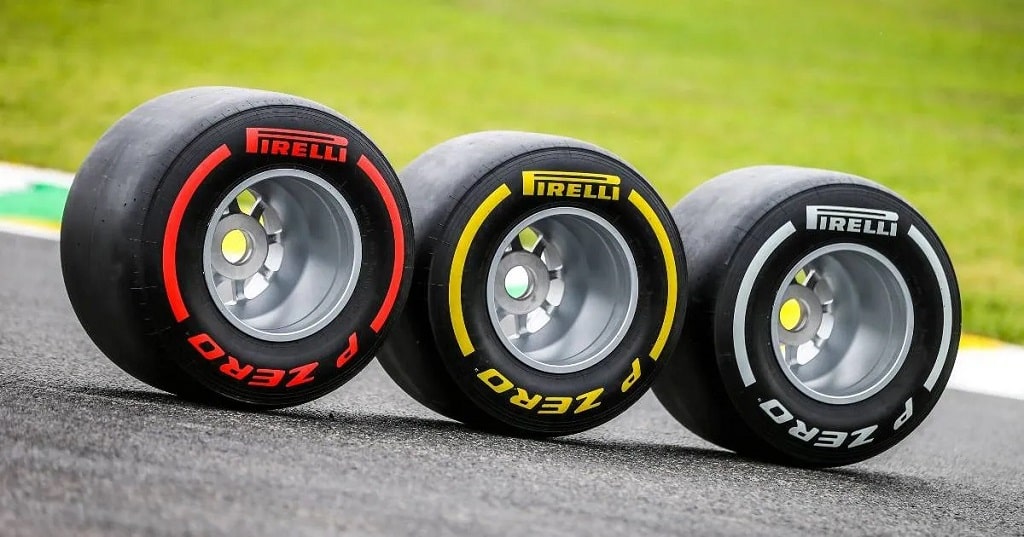
The tire compound refers to the hardness of the rubber used in the tire’s construction. Different compounds offer varying levels of grip and durability, making it essential to choose the right one for your racing needs:
- Hard Compound: These tires offer less grip but last longer, making them ideal for endurance races or practice sessions where tire longevity is a priority. Hard compound tires are also suitable for racers looking to save money on tire replacement costs.
- Soft Compound: Soft compound tires provide more grip but wear out faster, making them suitable for shorter races or qualifying sessions where maximum grip is needed. While these tires offer improved performance, be prepared for more frequent replacements due to their faster wear rate.
- Medium Compound: Medium compound tires balance grip and longevity, making them versatile for various racing conditions. These tires are popular among racers who want a tire that performs well in grip and durability without compromising on either aspect.
Factors to Consider When Choosing Go-Kart Tires
To select the best tires for your go-kart, consider the following factors:
- Type of track: Consider the surface and layout of the track where you’ll be racing. For example, choose slick tires for a smooth, paved track and dirt tires for off-road racing.
- Weather conditions: Always consider the weather when selecting tires. Wet tires are essential for rainy conditions, while slick tires are optimal for dry tracks.
- Driving style: Your driving style can impact tire wear and performance. Aggressive drivers may benefit from harder compounds that last longer, while more conservative drivers prefer softer compounds for better grip and handling.
- Budget: Your budget will influence your tire choice. While softer compounds offer better performance, they wear out faster and may require more frequent replacement, increasing overall costs. Consider the balance between performance and cost when selecting your tires.
Essential Tire Maintenance Tips
Proper tire maintenance is crucial to ensure optimal performance and extend the life of your go-kart tires. Follow these maintenance tips to keep your tires in top condition:
- Regularly check tire pressure: Maintaining the correct pressure is vital for optimal handling and longevity. Check your tire pressure before every race and adjust as necessary to meet the manufacturer’s recommendations.
- Inspect tires for damage: Before each race, inspect your tires for any signs of damage, such as cuts, punctures, or excessive wear. Replace damaged tires immediately to avoid compromising your safety and performance on the track.
- Rotate tires: Regularly rotating your tires can help ensure even wear and extend their life. Swap the front and rear tires and switch sides to promote more balanced wear across the tire set.
- Store tires properly: When not used, store your go-kart tires in a cool, dry place away from direct sunlight or extreme temperature fluctuations. Proper storage can help prevent premature aging and cracking of the rubber compound.
Related Article: What Is The Optimal Air Pressure for Go-Kart Tires
Manufacturers
Maxxis
Established in 1967, Maxxis has been a prominent name in the kart tire industry in the United States since 1997. Maxxis has a global presence and is well-regarded for maintaining strong relationships with track owners, promoters, and drivers.
| Tire Category | Description |
|---|---|
| Sprint | Slick, wet, and racing tires |
| Dirt | Oval tires for off-road racing |
| Concession | Tires designed for rental go-karts |
Hoosier
Bob Newton and his wife in Indiana founded an American company, Hoosier. Today, Hoosier offers over 1,000 different tires and is recognized for its high-quality go-kart tires that are exported worldwide.
| Tire Category | Description |
|---|---|
| R55 | Slick tires |
| R60A | Slick tires |
| R60B | Slick tires |
| R70 | Slick tires |
| R80 | Slick tires |
| WET | Wet weather tires |
Vega
Established in 1980, Vega is an Italian company that produces a wide range of go-kart tires. With production facilities in Italy and France, Vega offers slick, wet, and concession tires. Vega specializes in CIK-FIA homologated tires and closely collaborates with its team of drivers. Each tire undergoes at least 200 laboratory checks.
| Tire Category | Description |
|---|---|
| Slick | Slick tires |
| Rain | Wet weather tires |
| Rental | Concession go-kart tires |
Dunlop
Dunlop Kartsport is a renowned tire range that features four different series. They offer more than 60 different sizes across their range and primarily manufacture slick and wet tires. Although focused on homologated tires, they can also be used for leisure karting.
| Tire Category | Description |
|---|---|
| DF Series | Slick tires |
| KT Series | Wet weather tires |
| SL Series | Slick tires |
| DE Series | Slick tires |
MOJO
Initially developed to cater to Rotax 125 class engines, MOJO tires are manufactured in Dresden, Germany. Offering slick and wet tires for various karting classes, MOJO tires were widely commercialized in 2006 and are now available in more than 50 countries.
| Tire Category | Description |
|---|---|
| D2XX | Slick tires |
| D5 | Slick tires |
| W5 | Wet weather tires |
| C2 | Slick tires |
| CW | Slick tires |
MG Tires
MG Tires was founded in 1989 in Brazil and is known for using PAHs (polycyclic aromatic hydrocarbons) to create CIK-FIA homologated and non-homologated racing tires. The company offers various go-kart tires and works closely with track operators and drivers.
| Tire Category | Description |
|---|---|
| SM Series | Slick tires |
| SH Series | Slick tires |
| SW Series | Wet tires |
| SC Series | Slick tires |
| SCW Series | Wet tires |
| SS | Slick tires |
| SI | Slick tires |
| AZ | Slick tires |
| SD | Off-road tires |
| RL1 | Concession tires |
| RL2 | Concession tires |
| RL3 | Concession tires |
LeCont
LeCont, founded by brothers Sergio and Valter Cont, is an Italian manufacturer known for producing high-quality racing tires. All of their tires are CIK-FIA approved and homologated.
| Tire Category | Description |
|---|---|
| SVA Series | Slick tires |
| SVB Series | Slick tires |
| SVC Series | Slick tires |
| SV1 Series | Wet tires |
| SV2 Series | Wet tires |
| LH03 Series | Slick tires |
| LH05 Series | Slick tires |
| 4S Series | Slick tires |
| LH04 Series | Wet tires |
| MSA04 Series | All-weather tires |
Tire Preparation
Tire preparation solutions aim to enhance the grip of your go-kart tires on the racing track. This improved grip increases the “adhesiveness” of your tires to the track’s surface, leading to quicker lap times due to better handling around corners and during acceleration.
We have put together a comprehensive guide on effectively preparing your go-kart tires, offering additional tips worth checking out.
If you prefer a pre-made tire preparation solution, consult our recommendations for the top go-kart tire preparation formulas on the market, where we evaluate and rank the best options available.
By familiarizing yourself with the various types of go-kart tires and tire compounds, considering factors like track surface, weather conditions, and driving style, and utilizing the appropriate tire preparation techniques, you can optimize your racing performance and enjoy a thrilling go-kart experience.
Frequently Asked Questions
The frequency of tire replacement depends on factors such as the type of tire compound, track conditions, and your driving style. Generally, softer compound tires wear out faster and may need more frequent replacement. It’s essential to regularly inspect your tires for signs of excessive wear or damage and replace them as needed to ensure optimal performance and safety.
Related Article: Breathing New Life into Used Go-Kart Tires: Recycling and Creative Repurposing Ideas
While it’s possible to mix tire compounds, it’s not recommended as it can lead to inconsistent handling and performance. Using the same tire compound on all four wheels ensures a more balanced and predictable driving experience.
The ideal tire pressure can vary depending on track conditions, tire type, and kart setup. It’s crucial to consult your tire manufacturer’s recommendations for guidance on the appropriate pressure range. Generally, slick tires often require higher pressures, while wet or dirt tires may perform better at lower pressures.
Tire stagger refers to the difference in circumference between the left and right side tires on a go-kart. Stagger is used to help karts turn more effectively, particularly on oval or banked tracks. The kart can maintain a smoother line through corners by having a larger tire on the outside and a smaller tire on the inside. It’s essential to consult your kart manufacturer or an experienced racer for guidance on the optimal tire stagger for your specific setup and track conditions.
While some car tire sealants may work on go-kart tires, consulting your tire manufacturer or kart supplier for recommendations on suitable sealant products is best. Using the wrong type of sealant can lead to reduced tire performance, damage, or even failure. To ensure optimal performance and safety, always follow the guidelines provided by your tire or kart manufacturer.

Goran, an experienced go-kart racer, fuels GoKartLife.com with his passion and expertise. He offers valuable insights and tips for fellow enthusiasts, fostering the growth of the go-kart community. Join Goran at GoKartLife.com and immerse yourself in this exhilarating sport.
Last modified: December 11, 2024



